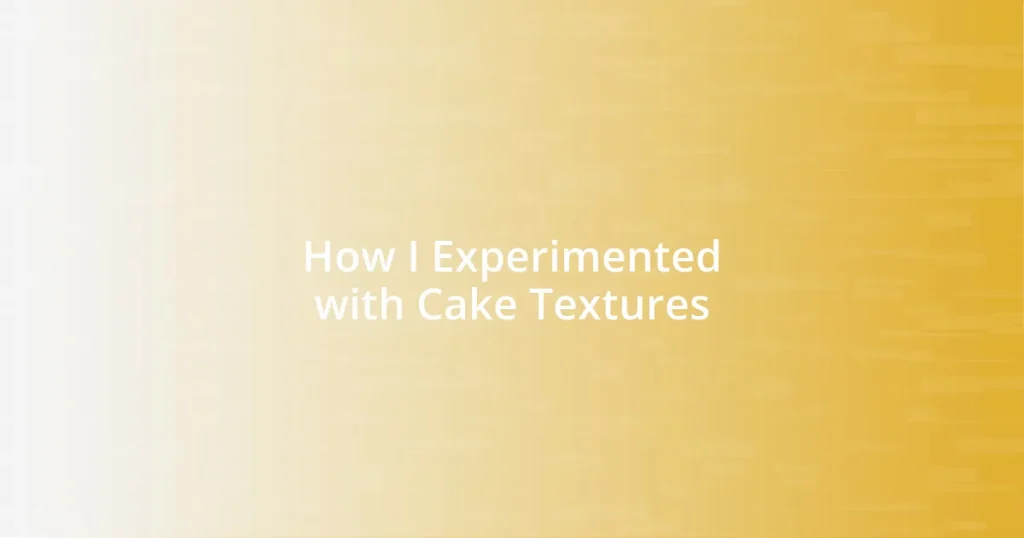Key takeaways:
- Texture significantly influences cake enjoyment and can transform a dessert from ordinary to memorable.
- Key techniques such as proper mixing, ingredient temperature, and moisture addition are crucial for achieving desired cake textures.
- Common mistakes include neglecting ingredient temperatures and rushing the mixing process, which can lead to poor texture outcomes.
- Cake flour versus all-purpose flour and the choice of fats (butter vs. oil) can dramatically affect the texture and flavor of cakes.

Understanding cake textures
When I first started baking, I had no idea that cake texture could be so nuanced. It’s fascinating how a cake can be airy and fluffy or dense and moist, depending on the ingredients and mixing methods used. Have you ever wondered why some cakes crumble while others hold their shape perfectly?
I remember a time when I experimented with a classic sponge cake recipe. The joy of whipping the eggs to the right volume was exhilarating! It made me realize that the air I incorporated into the batter was just as important as the ingredients themselves, as it directly affected the final texture. It’s almost like a dance between science and creativity, isn’t it?
One of the most surprising textures I encountered was the difference between a pound cake and a chiffon cake. The richness of the pound cake, with its buttery, tight crumb, contrasted sharply with the light, airy quality of the chiffon cake. It got me thinking: how does one decide which texture works best for different occasions? In my experience, choosing the right texture can elevate the overall cake experience, turning an ordinary dessert into a memorable one.

Importance of texture in cakes
Texture plays a significant role in our perception and enjoyment of cakes. I still recall the first time I made a genoise and marveled at its delicate crumb. It was light enough to barely register on my palate yet provided a satisfying bite, illustrating how texture can completely alter our experience with a simple cake. That moment made me appreciate how a well-executed texture can elevate a cake from merely edible to utterly delightful.
When I experimented with different types of flour, I found myself astonished by how much this simple ingredient influenced texture. Using cake flour instead of all-purpose flour produced a cake that was softer and melt-in-your-mouth, almost like a dreamy cloud. The subtle differences might seem trivial, but they significantly impact the overall mouthfeel and satisfaction of each bite, don’t you think? Catering to these textures has since become a vital part of my baking philosophy.
The interplay of moisture and texture is also essential. I once baked a chocolate cake that was too dense, leaving it dry and uninviting. It taught me that achieving a balance, where moisture and texture complement rather than compete, can transform the most basic ingredients into something magical. Experience has shown me that when I take the time to experiment with and understand texture, the resulting cakes not only taste better but also evoke richer emotions and memories for everyone who enjoys them.
| Texture Type | Characteristics |
|---|---|
| Light and Airy | Fluffy, delicate crumb, often made with whipped egg whites or cake flour |
| Dense and Moist | Rich, buttery flavor, often heavier with ingredients like butter or sour cream |

Different types of cake textures
Understanding the different types of cake textures is truly a delightful journey. The first time I created a chiffon cake, I was captivated by its unique lightness. It felt almost magical, like biting into a cloud. This fluffy texture, thanks to the whipped egg whites, really showed me how much air can change the cake experience. Contrast that with the first dense cake I made—an indulgent fudge cake. The richness enveloped my senses and left a lasting impression. The way both cakes could elicit such different feelings highlighted the power of texture in baking.
Different cake textures can be categorized, and each brings its own personality to the table. Here’s a quick breakdown of some common types:
- Sponge Cake: Light and airy, created by the aeration of eggs, often used in layered cakes.
- Pound Cake: Dense and rich, made with equal weights of flour, sugar, butter, and eggs, perfect for a buttery treat.
- Chiffon Cake: A lovely hybrid of sponge and pound cake, it’s light yet moist due to the oil and whipped egg whites.
- Genoise: A classic Italian cake that’s light but holds moisture well, making it ideal for soaking up syrups.
- Flourless Cake: Decadently rich and dense, these cakes are often chocolate-based and deliver an intense flavor with a fudgy texture.
Each texture evokes a different emotion and experience. Whether it’s the airy joy of a sponge cake at a celebration or the comforting hug of a pound cake on a cozy night, I find that every cake has a story to tell through its texture.

Ingredients affecting cake texture
Ingredients play a crucial role in shaping the texture of a cake, and this realization hit me like a sweet revelation during one of my baking adventures. I remember making a vanilla butter cake with a generous helping of buttermilk; the result was a moist, tender crumb that practically melted in my mouth. It’s fascinating how just one ingredient can provide both moisture and a slight tang, enhancing the overall flavor and experience.
In my quest for the perfect red velvet cake, I learned firsthand about the magic of oils versus butter. While butter gives that classic richness, using oil resulted in a softer, more tender texture that I couldn’t get enough of. Why is that? It’s because oil remains liquid at room temperature, keeping the cake moist longer. When I presented this vibrant cake to friends, they couldn’t get over how the texture seemed to invite them to take another slice. It became clear to me how texture and flavor are entwined in a delicious dance.
Sugar is another pivotal ingredient that influences texture, as I discovered while perfecting my chocolate cake. I decided to try brown sugar instead of white, and boy, did it make a difference! The cake turned out dense yet rich, adding a subtle molasses flavor that elevated every bite. Have you ever considered how the choice between granulated and brown sugar could affect the final product? It’s a delightful thought, realizing that a simple tweak can lead to a completely different cake experience. Each cake I attempt teaches me something new about balance and the artistry behind cake-making.

Techniques for experimenting with textures
Experimenting with textures is a thrilling aspect of baking that I simply can’t get enough of. One technique I’ve embraced is the method of creaming butter and sugar. I remember the first time I combined ingredients using this technique; the airy, fluffy mixture transformed into something magical. It was such a tangible example of how mixing properly can significantly impact the lightness of a cake. Why does this matter? Because that initial aeration sets the stage for the entire cake’s texture!
Another technique that stood out to me was folding in whipped egg whites at the end of mixing. The first time I tried this with a delicate Angel Food Cake, I was awestruck by how the subtle motion could maintain airiness without deflating those precious bubbles. It’s akin to giving your batter a warm embrace—gentle yet effective. Have you ever experienced that moment when you take a bite and realize that each forkful feels like a cloud? That’s the magic of gentle folding!
Additionally, varying baking times and temperatures can create a fantastic range of textures. I once decided to bake a batch of brownies in a slightly cooler oven than usual, and the result was an incredibly fudgy interior enveloped in a crusty top. The difference was palpable and invigorating, leading to a sweet debate among my friends over whether they preferred the traditional chewy brownie or the newer creamy version. Isn’t it fascinating how small adjustments can shift the entire experience? Each experiment has opened my eyes to new possibilities, encouraging me to push the boundaries of traditional baking and explore textures I never imagined I could create.

Common mistakes in texture experimentation
When it comes to experimenting with cake textures, one common mistake I’ve encountered is not paying attention to ingredient temperatures. I once made a classic sponge cake using cold eggs straight from the refrigerator, thinking it wouldn’t matter. The result? A dense, lackluster cake that was far from the light, airy treat I desired. I realized then how vital it is to let ingredients reach room temperature; it can dramatically influence how well they incorporate and aerate.
Another pitfall I’ve seen is the tendency to rush the mixing process. I vividly remember the first time I whipped up a chiffon cake. I was eager to see the results and hurried through the mixing, leading to a flat cake that could hardly rise. I learned the hard way that taking my time to properly mix and aerate the batter creates those delightful pockets of air that transform a good cake into a great one. Isn’t it incredible how a little patience can make all the difference?
Lastly, underestimating the baking environment can derail your texture goals. I once baked a batch of cupcakes on a hot summer day, neglecting to account for the humidity in my kitchen. The result was a batch of cupcakes that deflated and became gummy. It was a stark reminder that external factors like humidity and oven calibration play a significant role in achieving the desired texture. Have you ever made a beautiful dessert, only for it to fall flat due to something beyond your control? It’s these lessons that remind me to always keep an eye on my environment when baking!

Tips for perfecting cake textures
One of the best tips I can share for perfecting cake textures is to pay close attention to your mixing. I remember a particularly frustrating day when I mixed my ingredients too aggressively while making a red velvet cake. Instead of that nice, soft crumb I was aiming for, I ended up with a dense and rubbery disaster. Now, I gently whirl my batter, allowing the ingredients to blend without losing the airiness that creates that dreamy texture.
I also believe in the power of experimenting with additional ingredients to enhance moisture. One time, I added a touch of sour cream to a basic vanilla cake batter, and the difference was astounding. It resulted in a moist, tender cake that had my friends asking for seconds—and maybe even thirds! Have you ever tried adding sour cream or yogurt to your recipes? The added tang not only moistens but also enriches the flavor profile, making each bite a little more decadent.
Finally, don’t overlook the importance of testing for doneness. I can’t tell you how many times I’ve pulled a cake out of the oven, only to realize it was either undercooked or overbaked. I’ve learned to trust my instincts and use the toothpick method, which involves inserting a toothpick into the center of the cake. It should come out clean or with a few moist crumbs attached, but not wet batter. Mastering this simple test is like having a secret weapon in the kitchen—one that guarantees your efforts in achieving that perfect texture don’t go unnoticed!















